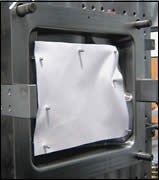Injection molding for interiors—including fabrics
Plenty of interior components are injection molded. But some companies—such as VW—are using a process for trim pieces that both mold a component and cover it in fabric in a single molding process. And it is coming to the U.S. in the not-too-distant future.
#interior
"Our work cells are running in VW plants." That's Chris Gassel, Advanced Engineering, Polymer Technology, North American Operations (Auburn Hills, MI). He's talking about cells that are being used to injection mold interior parts for vehicles including the Golf. As everyone—inside and outside Detroit, vehicle manufacturers and consumers alike—knows, VW interiors are the touchstone. So when he talks about molding cells that pgam has engineered being used for VW interiors, it is of more than moderate interest. Especially since what he's talking about he has a version of right on the floor of the pgam facilities. The cells in Germany are in production. They're injection molding cells. They are injection molding A-, B- and C-pillars. But if this was just about VW injection molding A-, B- and C-pillars, it wouldn't be much of a story. After all, that's not a big deal.
What is a big(ger) deal is the fact that VW is using an in-mold laminate process. Or, in other words, they're injection molding the trim pieces for the pillars right onto the back of fabrics. Which explains, in part, why the interiors of VWs are so nice.
One more thing: "A lot of the 2007 products that we are quoting right now have full intent to go to in-mold lamination," Gassel adds. He's talking about North American producers. According to Larry Doyle, North American and International Marketing product manager for Demag Plastics Group Corp. (Strongsville, OH), the supplier of the horizontal injection-molding machine on the floor at pmag, the process was actually introduced at the K Show in Germany—in 1986. It is taking what was initially called "low-pressure processing" a bit of time to cross the Atlantic.
Generally, the way the trim parts for the pillars are produced is through the use of both machinery and manpower. And adhesive. That is, the plastic parts are molded and removed from the injection molding machine. Then people drape fabric over the molded parts and used adhesive to provide a mechanical bond between the substrate and the fabric. While this certainly works, there are considerations. Such as the necessity for secondary operations (make the part; drape/glue/trim). And the fact that solvents are being used.
The system developed by pgam, Demag, and automation supplier Wittmann (Torrington, CT) is far more efficient. That is, first there are the fabric blanks, pieces that have been cut to the necessary size (allowing for some trim to be removed post-molding), then stacked. A handling robot moves to the stack of blanks, then pneumatically actuated needles emerge about 0.125 in. from the end-of-arm tooling to engage the textile. The robot's tooling has two working sides: this cloth-piercer and fingers that can remove a finished part from the mold. So in operation, the textile is picked up, the robot moves into the mold area and removes a part, indexes so that the cloth can be draped on retainer pins in the mold, drapes the textile, then moves out of the mold and places the finished part on an outgoing conveyor. Then the molding proceeds. Parts that have been molded are trimmed. In the case at pgam, an ultrasonic unit is in place. Laser trimming and waterjet cutting are also deployed.
According to Gassel, one of the key issues with this process is precise control. Control of not only the material handling, but of the injection molding process itself, the machinery and the material. Although this was originally, as noted, a low-pressure process, Gassel says that they are now "shooting it at full-closed mold, as opposed to a compression process. We're not pooling the material. We're controlling the fill using the controller." The Demag Ergotech molding machines have what's called the "NC4" control system that facilitates the control of 48 different zones during the cascade injection process used here. Another aspect of the machines that is important to the process is the wide distance between the tie bars. This width is necessary because of the comparatively large size and mass of the molds. The machine on the floor at pgam, the System 350/1250, has a clamping force of 3,500 kN, yet the distance between the tie rods is 1,250 mm, which is what is more ordinarily found on 8,000-kN machines. Presently, they are moving beyond the use of polypropylenes to testing out acrylonitrile butadiene-styrene (ABS) materials. ABS is characterized by such things as good moldability, dimensional stability, temperature resistance, and dimensional stability. Which explains why it is often used in vehicle interiors for various components. They are also testing out polycarbonate-ABS blends. And they're testing different fabrics, vinyls, and even leathers. With more than 15 years' experience in production operations, they're still pushing the process to see what they can do.
RELATED CONTENT
-
Engineering the 2019 Jeep Cherokee
The Jeep Cherokee, which was launched in its current manifestation as a model year 2014 vehicle, and which has just undergone a major refresh for MY 2019, is nothing if not a solid success.
-
2019 Mazda3 Sedan Premium FWD
As Mazda pivots to “premium,” it is doing more than just talking about it, as the new Mazda3 proves.
-
2017 Mazda MX-5 Club RF
The Mazda slogan “Driving Matters” pretty much sums up the 2017 MX-5 Miata Club RF.


.jpg;width=70;height=70;mode=crop)

